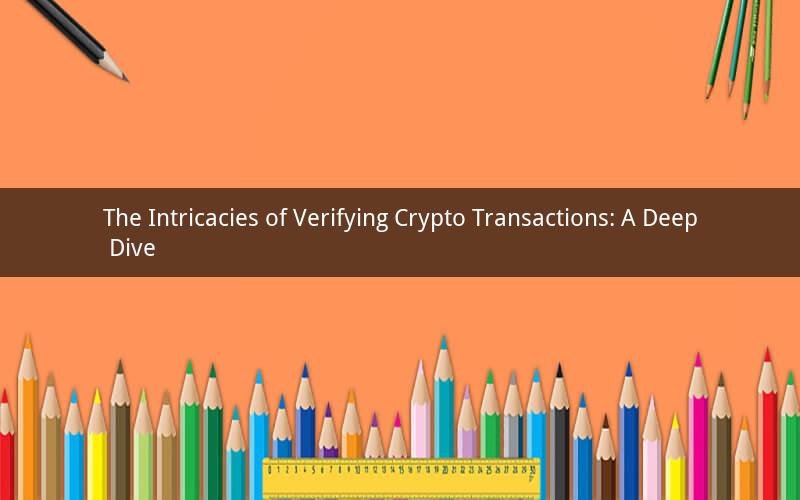
In the world of cryptocurrencies, transaction verification is a pivotal process that ensures the integrity and security of the entire network. How are crypto transactions verified? This article delves into the mechanisms and technologies behind this critical aspect of the blockchain ecosystem.
The blockchain, a decentralized ledger, relies on a consensus mechanism to verify transactions. This mechanism varies across different cryptocurrencies, but the ultimate goal remains the same: to ensure that transactions are legitimate, secure, and recorded accurately.
One of the most popular consensus mechanisms is Proof of Work (PoW). In PoW, miners compete to solve complex mathematical puzzles, and the first to solve the puzzle gets to validate transactions and add them to the blockchain. This process is known as mining. Let's explore how PoW verifies crypto transactions in more detail.
How does Proof of Work verify crypto transactions?
1. Transaction Input and Output: When a user initiates a transaction, the blockchain records the sender's public key (address) as the input and the receiver's public key as the output. This ensures that the sender has the right to transfer the funds.
2. Digital Signature: The sender signs the transaction with their private key, which creates a unique digital signature. This signature is used to verify that the sender is the legitimate owner of the funds and that the transaction is valid.
3. Mining Puzzles: Miners receive a batch of transactions and attempt to solve a complex mathematical puzzle. The puzzle requires finding a number that, when hashed with the transaction data, results in a value that meets specific criteria (e.g., a certain number of leading zeros).
4. Block Creation: Once a miner solves the puzzle, they create a new block containing the verified transactions. This block is then added to the blockchain, and the miner is rewarded with cryptocurrency for their efforts.
5. Consensus and Security: The PoW mechanism ensures that all participants in the network agree on the order of transactions and the validity of the blockchain. This consensus mechanism makes it extremely difficult for malicious actors to alter the blockchain or create fraudulent transactions.
While PoW is widely used, it has its drawbacks, such as high energy consumption and slow transaction speeds. As a result, many cryptocurrencies have adopted alternative consensus mechanisms, such as Proof of Stake (PoS). Let's explore how PoS verifies crypto transactions.
How does Proof of Stake verify crypto transactions?
1. Validator Selection: In PoS, validators are chosen based on the amount of cryptocurrency they hold in their wallets. The more cryptocurrency a user holds, the higher their chances of becoming a validator.
2. Random Selection: Validators are randomly selected to create new blocks and validate transactions. This random selection ensures that the network remains decentralized and prevents any single entity from having too much control.
3. Transaction Validation: Once a validator is selected, they are responsible for validating transactions and adding them to the blockchain. Similar to PoW, the sender's digital signature is used to verify the transaction's legitimacy.
4. Reward Distribution: Validators who successfully validate transactions are rewarded with cryptocurrency. The reward is proportional to the amount of cryptocurrency they have staked, which incentivizes users to hold and secure the network.
5. Security and Scalability: PoS offers improved scalability and energy efficiency compared to PoW. Since validators are chosen based on their stake in the network, the process of verifying transactions is faster and requires less computational power.
Other consensus mechanisms, such as Delegated Proof of Stake (DPoS) and Practical Byzantine Fault Tolerance (PBFT), also aim to verify crypto transactions efficiently and securely. Each mechanism has its unique features and advantages, making the verification process more robust and adaptable to various use cases.
Now that we have explored the mechanisms behind verifying crypto transactions, let's address some common questions about this process.
1. What is the purpose of verifying crypto transactions?
The purpose of verifying crypto transactions is to ensure the integrity, security, and trustworthiness of the blockchain network. This process prevents fraudulent activities, doublespending, and unauthorized access to funds.
2. How does transaction verification prevent double-spending?
Transaction verification prevents double-spending by ensuring that the sender has sufficient funds to transfer. Once a transaction is confirmed and added to the blockchain, the sender cannot spend the same funds again.
3. Can transaction verification be bypassed?
It is extremely difficult to bypass transaction verification in a blockchain network. The consensus mechanism and cryptographic algorithms make it nearly impossible for malicious actors to alter the blockchain or create fraudulent transactions.
4. How long does it take to verify a crypto transaction?
The time it takes to verify a crypto transaction varies depending on the consensus mechanism and the network's current congestion. In PoW, transactions can take minutes to hours, while in PoS, they can be verified in seconds to minutes.
5. What are the potential challenges in verifying crypto transactions?
The potential challenges in verifying crypto transactions include scalability, energy consumption, and network congestion. As the number of transactions increases, the network may experience slower processing times and higher energy demands.
In conclusion, verifying crypto transactions is a crucial process that ensures the security and reliability of the blockchain network. By understanding the mechanisms behind this process, we can appreciate the complexity and sophistication of the cryptocurrency ecosystem. As the industry continues to evolve, it is essential to address the challenges and improvements needed to enhance the transaction verification process further.